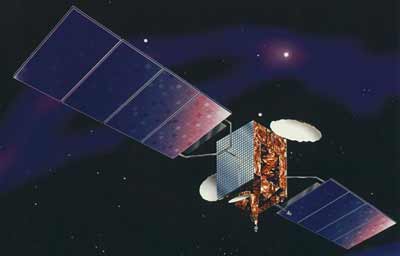Thank you very much for visiting Gunter's Space Page. I hope that this site is useful and informative for you.
If you appreciate the information provided on this site, please consider supporting my work by making a simple and secure donation via PayPal. Please help to run the website and keep everything free of charge. Thank you very much.
Intelsat-8A (805, 806) / NSS 806

Intelsat-8A [Lockheed Martin]
The Intelsat VIII-VIII/A series has been designed to meet the needs of Intelsat users throughout the system for improved C-band coverage and service. These spacecraft will incorporate six-fold C-band frequency reuse, two-fold frequency reuse of expanded C-band capacity, and the highest C-band power level ever for an Intelsat satellite. Consequently, Intelsat VIII will provide significantly more C-band capacity for public switched telephony and Intelsat Business Service, better quality for video services, and encourage new international VSAT applications.
Other salient features of Intelsat VIII satellites include:
- Two independently steerable Ku-band spot beams which can be pointed anywhere on the surface of the earth that is visible from the spacecraft in geosynchronous orbit.
- Interconnected operation between C- and Ku-bands.
- Expanded SNG (satellite news gathering) service provided by the capability to connect spot beams to global beams, including a return path for small Ku-band transportable SNG stations for voice/data communications.
This deployment of Intelsat 805 was originally scheduled to use a Chinese CZ-3B rocket. However, Intelsat bailed out of that plan after losing one of its satellites in a 1996 catastrophic launch explosion of a CZ-3B booster.
In January 2020 Intelsat 805 was put into a graveyard orbit and was passivated.
| Nation: | International, Netherlands (NSS) |
|---|---|
| Type / Application: | Communication |
| Operator: | Intelsat / New Skies (NSS) |
| Contractors: | Lockheed Martin |
| Equipment: | 28 C-band transponders, 3 Ku-band transponders |
| Configuration: | AS-7000 |
| Propulsion: | 2 × LEROS-1b |
| Power: | 2 deployable solar arrays, batteries |
| Lifetime: | 14-17 years, depending on the launch vehicle |
| Mass: | 3524 kg |
| Orbit: | GEO |
| Satellite | COSPAR | Date | LS | Launch Vehicle | Remarks | |
|---|---|---|---|---|---|---|
| Intelsat 805 | 1998-037A | 18.06.1998 | CC SLC-36A | Atlas-2AS | ||
| Intelsat 806 → NSS 806 | 1998-014A | 28.02.1998 | CC SLC-36B | Atlas-2AS |
